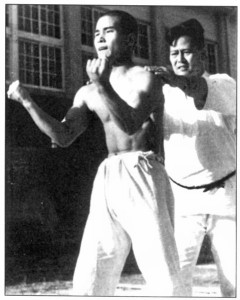Three battles.
by Ryan Gregory, February 19th, 2012The foundational kata in Okinawan Goju-ryu is Sanchin, or “Three Battles”. The simplest interpretation is that the kata is meant to simultaneously focus the mind, body, and spirit. The kata contains only one stance (the eponymous sanchin dachi, also called “hourglass stance”) and for the most part consists of straightforward middle blocks and punches, with a few additional techniques near the latter part of the sequence. And yet, Sanchin is one of the most challenging kata to perform correctly — precisely because it involves much more than the movements of the body. It is not something that one perfects, it is something to work on throughout one’s training.
In addition to the sequence of steps, turns, blocks, and punches, performing Sanchin requires strong mental focus, the use of proper breathing, and a balance between the hard (go) and soft (ju) of Goju-ryu. I freely admit that this kata is the one I am finding the most challenging as I am returning to some manner of decent form. In part, my performance of the kata is rather poor because I am consciously thinking of the sequence, the breathing, the timing, the turns, the target for the punches, the position of the hands, and so on. In the past, I could do this kata without thinking about any of this, which was neceessary in order to have the proper mental focus when being tested.
Tested in this case does not mean graded, it refers to the practice of having one’s technique and focus physically checked by an instructor. This is known as shime, and it varies in severity from lightly pushing on the student to check the strength of the stance or providing resistance as the student performs a punch, to much harder methods of testing.

Goju-ryu founder Chojun Miyagi performing shime on a student. As the story goes, Miyagi's students were easily distinguishable by the bruises they often sported from such testing.
Here is an example of Sensei Kazuo Terauchi (8th Dan) being tested by Sensei Morio Higaonna (10th Dan):
Note the focus and strength of the stance and techniques. Very impressive.
Another good example (also involving testing by Sensei Morio Higaonna):
Here is another example, this time using wooden dowels to test the student in rather dramatic fashion:
Here’s another in which the student is tested using a shinai, a bamboo sword used in the martial art of Kendo:
I have been tested with a shinai. The truth is, when you’re fully focused on the kata, you don’t really feel the pain — but you certainly hear the impact and you see the marks afterward. For the most part, though, we were tested with hands and feet only. Obviously, I am not even close to the level where I can be tested in this way anymore, but in time I hope to get back to it.
I think the three battles of Sanchin reflect my current situation quite well in another way. Obviously, there is the issue of getting my body back into decent physical condition. I also need to re-train myself to perform techniques correctly with both power and speed, and to commit new training sequences to muscle memory.
Mentally, I am working to learn new kata on a conscious level (this is necessary before they can become automatic), and I am also reading as much as I can about Goju-ryu in general and Meibukan Goju-ryu in particular. I am a scholar by profession, so delving into the intellectual aspects of training is important for me.
Finally, I think the battle of the spirit is reflected in the need to be patient with my progress and not to become overly frustrated with myself when I am unable to do what I used to be able to do. I also have had to get over the sense of lost pride that comes with wearing a white belt instead of a formerly much higher rank (not to mention that I also have titles outside of the dojo and am not used to being so junior anymore). Let me say, however, that I think Sensei’s decision for me to start at white belt absolutely was the right one, regardless of whether I end up grading all the way through again or am allowed to don my brown belt again at some point after I get sufficiently caught up. This has allowed me to ease back into the training and to give myself an opportunity to catch up without imposing a lot of unrealistic expectations on myself or adding responsibilities that I am not currently equipped to handle, such as helping junior belts. A lesson in humility is a good thing in general anyway.
It has only been a month since I returned to training, but I already feel more at home in the dojo and am confident that I can build upon what was a solid foundation of training in the past. In fact, I believe I can be much better than I ever was and that this experience will turn out to be quite beneficial in the end. Physically, mentally, and spiritually.

 Brazilian Jiu-Jitsu
Brazilian Jiu-Jitsu
 Kodokan Judo
Kodokan Judo


